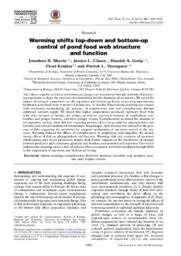Shurin, Jonathan B.
Person Preferred Name
Jonathan B. Shurin
Related Works
Content type
Digital Document
Abstract
Interactions between trophic levels during food web assembly can drive positive correlations in diversity between producers, consumers, and decomposers. However, the contribution of trophic interactions relative to local environmental factors in promoting species diversity is poorly understood, with many studies only considering two trophic levels. Here we examine correlations in diversity among zooplankton, phytoplankton, and bacteria in the pelagic zone of 31 lakes in British Columbia, Canada. We sampled species diversity of zooplankton and phytoplankton through morphological identification, and bacterial genetic diversity was estimated by denaturing gradient gel electrophoresis (DGGE) of 16S rDNA polymorphisms. We looked for correlations in diversity that were independent of the abiotic environment by statistically controlling for 18 limnological variables. No significant correlations were found between the diversity of zooplankton, phytoplankton, and bacteria. In addition, the physical factors that were associated with species composition in one trophic level were independent of those that were important for another. Our results provide no support for the importance of direct feedbacks between producers, consumers, and decomposers in maintaining diversity. Zooplankton, phytoplankton, and bacterial diversity and composition are regulated independently from one another and respond to different environmental variables. These results suggest that species of lake plankton show loose trophic associations with one another due to broad diets in consumers and decomposers.
Origin Information
Content type
Digital Document
Abstract
The effects of global and local environmental changes are transmitted through networks of interacting organisms to shape the structure of communities and the dynamics of ecosystems. We tested the impact of elevated temperature on the top-down and bottom-up forces structuring experimental freshwater pond food webs in western Canada over 16 months. Experimental warming was crossed with treatments manipulating the presence of planktivorous fish and eutrophication through enhanced nutrient supply. We found that higher temperatures produced top-heavy food webs with lower biomass of benthic and pelagic producers, equivalent biomass of Zooplankton, zoobenthos and pelagic bacteria, and more pelagic viruses. Eutrophication increased the biomass of all organisms studied, while fish had cascading positive effects on periphyton, phytoplankton and bacteria, and reduced biomass of invertebrates. Surprisingly, virus biomass was reduced in the presence of fish, suggesting the possibility for complex mechanisms of top-down control of the lytic cycle. Warming reduced the effects of eutrophication on periphyton, and magnified the already strong effects of fish on phytoplankton and bacteria. Warming, fish and nutrients all increased whole-system rates of net production despite their distinct impacts on the distribution of biomass between producers and consumers, plankton and benthos, and microbes and macrobes. Our results indicate that warming exerts a host of indirect effects on aquatic food webs mediated through shifts in the magnitudes of top-down and bottom-up forcing.
Origin Information
Content type
Digital Document
Abstract
Bacteria are ubiquitous and important components of marine ecosystems, yet the interaction between bacteria and higher trophic levels remain poorly understood. The trophic cascade involving sea otters, urchins, and kelp in the North Pacific is a classic case of altered ecosystem states; however, its impacts on microbial communities are unknown. We investigated the response of microbial communities to variation in kelp abundance between regions with and without sea otter populations along the west coast of Vancouver Island, British Columbia, Canada. We compared bacterial community structure and function between regions with large and small kelp forests, including an subset of the bacterial community that produces alginate lyase, which allows direct utilization of kelp carbon. The abundance and activity of alginate-lyase-producing bacteria were 3.2 and 1.4 times higher, respectively, in the region with large kelp forests, and declined rapidly with increasing distance from kelp. Total bacterial abundance was 2.7 times greater, and bacteria grew faster and experienced more zooplankton grazing and viral-mediated mortality in the presence of large kelp forests. These patterns suggest that larger kelp forests produce more detritus and dissolved organic matter, which stimulate microbial activity. Our results indicate that variation in kelp forest size alters the community structure and productivity of microbes and contributes to the growing evidence that top predators interact with microbes and ecosystem processes through a cascade of indirect effects.
Origin Information



